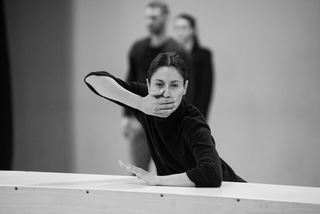Conversation with Josephine Machon, Brunel University London | November 2006
JM: Talk to me a little about your approach within the Punchdrunk aesthetic.
MD: I’m really interested in the dancers’ ability to feel the space, touch spaces textures surfaces, temperatures. I’m really interested in partner based work, weight and the weight of another body in space. So structures and levels allow the individual dancer to experience their own weight in a different way. In a way, it allows them to be more than human.
JM: To become like architecture?
MD: Not to become like architecture, to use the architecture as a springboard for different possibilities; to jump to fall to crash to bang to impact, to place themselves within an already existing physical context. I think just being interested in the cinematic and in the possibilities for framing that a space offers, a physical framing and narrative remain. My work is all about stories and all about narratives. You might receive these in a non-linear way but the narratives are there. So the visual frame and the psychology of space it, the visual frame really affects the body and the choreographic decisions you make as a choreographer.
JM: Does the space allow access to something sensual that exists with the psychology of the characters narratives?
MD: In Sleep No More the performer playing Macbeth was having real difficulties accessing the psychology of Macbeth before he kills Duncan. He just couldn’t get it in the rehearsal studio. But as soon as he discovered this room, with spikes all over the walls he was instantly able to find something that opened that up for him. The spikes, and the claustrophobic dimensions of the space, allowed him to unlock what he should be feeling and communicating at that time. So the space offers up more possibilities for the performer to interpret their role beyond the immediate and beyond the studio. It offers both physical and psychological dimensions. Moving in a room with spikes automatically creates a metaphorical sense of his state and the emotional depth of the character.
JM: So the performers find the psychology through the environment?
MD: Thinking about Faust that space was an empty warehouse – as a found space it offered potential atmosphere but big empty spaces aren’t always exciting, experientially or choreographically. So Felix designs lots of mini sets within the space to make it more poetic. In terms of the psychology of the narratives, the space does help you solve the conundrums actually. In Faust, just after Faust has killed Valentine, he’s in a real state and the next scene we had set for him was his hell – an epic scene, choreographically epic. I had a conversation with Dan regarding this, his wilderness scene and he said, ‘to get me ready for my damnation I need something to happen to me, I need some process or some movement language so that I can arrive in this broken down state’, but he couldn’t find anywhere in the space for that to happen. Also we went back to the text and I gave him that text, his story, and I said learn it because I didn’t feel it was a physical response that we should start from. So just playing in his story he found a place under the staircase in his hell and he found the place to perform the text and then the text became really physical because of the space it was in under the dark stairwell. When the audience came in to the equation it became bigger. So that element grew organically – grew really gradually through a process. The performer had to find the place to be at the point – it was a wholly sensuous interpretation for him. It was a very different process. He already had the language he just had to find a place to let the textual language speak through movement. Which is interesting because there’s hardly any speech in the show.



